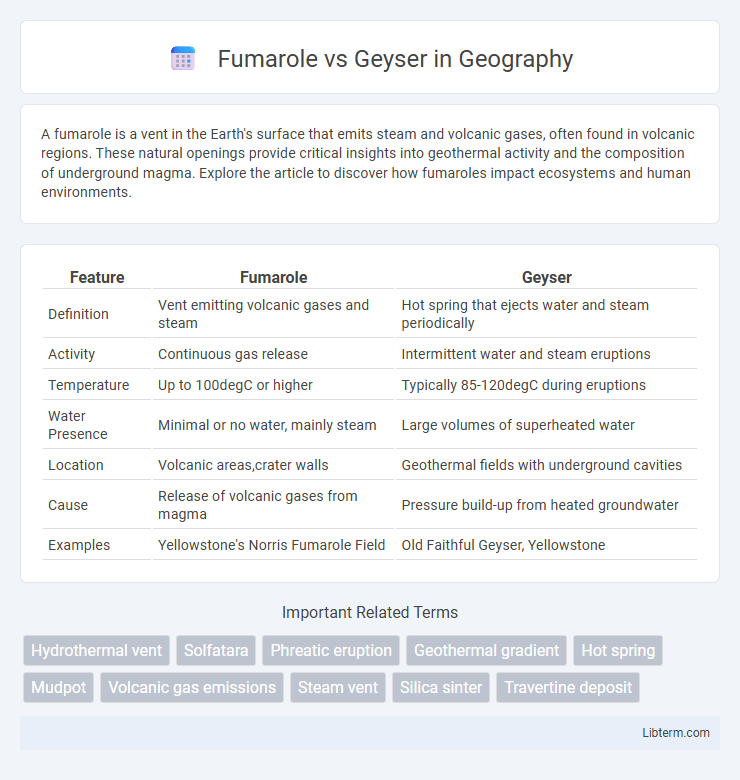A fumarole is a vent in the Earth's surface that emits steam and volcanic gases, often found in volcanic regions. These natural openings provide critical insights into geothermal activity and the composition of underground magma. Explore the article to discover how fumaroles impact ecosystems and human environments.
Table of Comparison
| Feature | Fumarole | Geyser |
|---|---|---|
| Definition | Vent emitting volcanic gases and steam | Hot spring that ejects water and steam periodically |
| Activity | Continuous gas release | Intermittent water and steam eruptions |
| Temperature | Up to 100degC or higher | Typically 85-120degC during eruptions |
| Water Presence | Minimal or no water, mainly steam | Large volumes of superheated water |
| Location | Volcanic areas,crater walls | Geothermal fields with underground cavities |
| Cause | Release of volcanic gases from magma | Pressure build-up from heated groundwater |
| Examples | Yellowstone's Norris Fumarole Field | Old Faithful Geyser, Yellowstone |
Introduction to Fumaroles and Geysers
Fumaroles are openings in the Earth's crust that emit steam and volcanic gases, primarily sulfur dioxide and carbon dioxide, indicating underlying geothermal activity. Geysers, on the other hand, are intermittent hot springs that periodically erupt water and steam due to the buildup of pressure within geothermal reservoirs. Both features are prominent in volcanic regions and serve as key indicators of subterranean hydrothermal processes.
Defining Fumaroles: Key Characteristics
Fumaroles are geothermal features characterized by vents releasing steam and volcanic gases such as sulfur dioxide and hydrogen sulfide, typically found in volcanic regions. Unlike geysers, fumaroles do not erupt water but emit hot gases continuously or intermittently, often creating sulfur deposits around their openings. Their temperatures can exceed 100degC, and they indicate subterranean volcanic activity by venting steam from heated groundwater or magma.
Geysers Explained: Unique Features
Geysers are rare hydrothermal features that periodically erupt hot water and steam due to underground geothermal pressure, distinguishing them from fumaroles which primarily emit steam and gases without explosive activity. Unique features of geysers include their reservoir system, which traps water that heats under pressure until a critical threshold causes a violent discharge. This cycle creates spectacular eruptions visible at famous sites like Yellowstone National Park and Iceland, where mineral deposits often form distinctive geyser cones.
Formation Processes: Fumarole vs Geyser
Fumaroles form when volcanic gases escape through cracks in the earth's surface, releasing steam and sulfurous gases without significant water discharge. Geysers develop when groundwater is heated by magma, causing pressure buildup until water erupts violently through surface vents. The key difference lies in fumaroles emitting gas and steam continuously, while geysers produce episodic water eruptions driven by boiling and pressure release.
Chemical Composition of Emissions
Fumaroles primarily emit gases such as water vapor, carbon dioxide, sulfur dioxide, and hydrogen sulfide, reflecting the volcanic rock interaction beneath the surface. Geysers release primarily steam and hot water, with lesser amounts of dissolved minerals and gases like silica and calcium carbonate, due to the rapid condensation of superheated groundwater. The distinct chemical composition of fumarole emissions often indicates active magmatic degassing, while geyser emissions are more influenced by the hydrothermal system's water-rock interactions.
Geographic Distribution and Locations
Fumaroles predominantly occur in volcanic regions with high geothermal activity such as Yellowstone National Park in the USA, Kamchatka Peninsula in Russia, and the Aeolian Islands in Italy. Geysers are much rarer and primarily found in geothermal hotspots like Yellowstone National Park, Iceland, and New Zealand's Taupo Volcanic Zone. Both fumaroles and geysers are indicators of active subterranean volcanic systems but differ significantly in their eruption mechanisms and geographic concentration.
Eruptive Behavior and Activity Patterns
Fumaroles emit steam and volcanic gases continuously or intermittently without explosive eruptions, indicating sustained degassing from magma beneath the surface. Geysers erupt periodically with violent bursts of water and steam caused by the buildup and rapid release of geothermal pressure within underground chambers. The eruptive behavior of fumaroles is relatively steady and low-intensity, while geysers exhibit cyclical and dramatic eruptions linked to specific hydrothermal conditions.
Ecological and Environmental Impacts
Fumaroles emit volcanic gases like sulfur dioxide and carbon dioxide, contributing to air pollution and acid rain that can harm nearby vegetation and aquatic systems. Geysers release heated water and steam, creating unique thermal habitats that support specialized microbial life but can be sensitive to environmental disturbances and human activity. Both geothermal features influence local ecosystems by altering soil chemistry and temperature, impacting biodiversity and ecological balance.
Famous Examples Worldwide
Fumaroles, such as those at Yellowstone National Park in the United States and the Solfatara crater in Italy, emit steam and volcanic gases from the Earth's crust, while geysers like Old Faithful in Yellowstone and Strokkur in Iceland explosively release jets of hot water and steam at regular intervals. Both geothermal features are critical indicators of volcanic activity, with Yellowstone hosting the world's largest concentration of these phenomena. The energetic eruptions of geysers and continuous gas emissions of fumaroles provide valuable insights into subterranean hydrothermal systems and geothermal energy sources across prominent global locations.
Fumaroles vs Geysers: Key Differences and Similarities
Fumaroles and geysers are both geothermal features found in volcanic regions, but fumaroles emit steam and volcanic gases continuously, while geysers release periodic bursts of hot water and steam. The key difference lies in their eruption process: fumaroles vent gases through cracks, whereas geysers erupt due to pressure build-up from underground water reservoirs. Both features indicate high underground heat, reflecting volcanic activity and geothermal energy potential.
Fumarole Infographic

 libterm.com
libterm.com